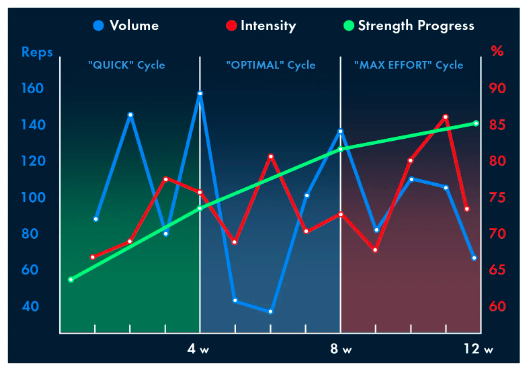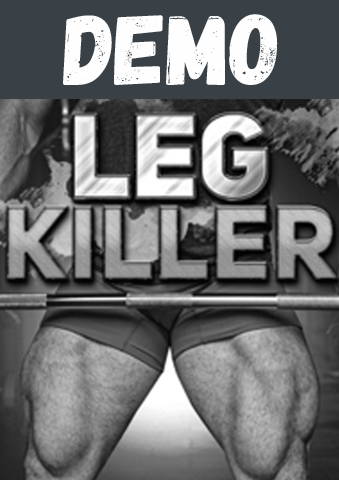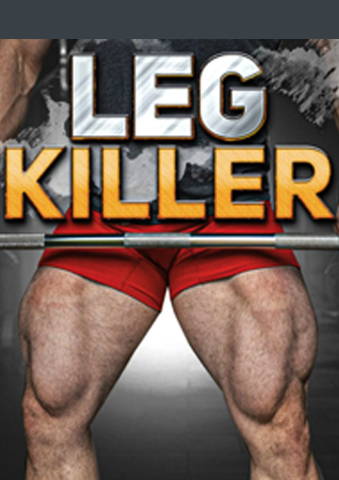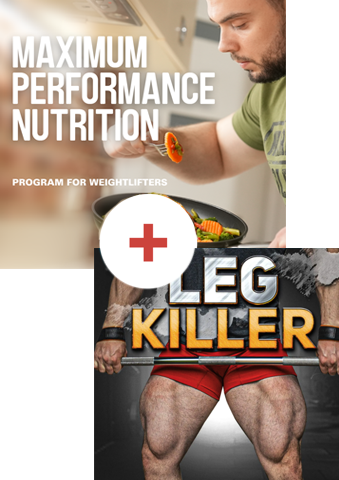Leg Workout Program
ACHIEVE YOUR DREAM LEGS
DURATION
ALL IN ONE
DAILY GUIDES
LEG STRENGTH
GOOD FOR
This innovative , adaptable leg workout plan is for anyone—man or woman, beginner or advanced—who is ready to work both hard and smart.
BASED ON
I've come a long way. This lower body workout plan emphasis on everything I've learned over the last 15 years. Expect bodyweight movements, banded work, and weight training.
KEY FEATURES
✔ Accessory work for core, joint stability and injury prevention;
✔ Instructional videos to guide your practice and make execution easy;
✔ Accessible on any device.
CUSTOMIZED DURATION

The load in the main exercises has a wavy structure and is interconnected between weeks in such a way that after 4, 8 and 12 weeks, the athlete is brought to the peak of the supercompensation phase by 10-14 days after the end of the program.
LOAD DETALIZATION

This legs workout schedule contains a wavy volume, intensity and variated routine to not only keep things interesting - but to also maintain progression towards the intended goal.
All main exercises contain detailed and specified training load.
PRICING

DEMO
FREE

LEG KILLER

LEG KILLER + Nutrition
4-week training plan
3 sessions
✓
✓
Workout Tutorial Videos
−
✓
✓
Performance Nutrition
−
−
✓
#LifeTime Access
✓
✓
✓
*Men's Maximum Performance Nutrition is selected by default.
To get Women's Nutrition Program contact us via online chat on the page or via email - direct@torokhtiy.com

DEMO
FREE

LEG KILLER

LEG KILLER + Nutrition
4-week training plan
Workout Tutorial Videos
−
Performance Nutrition
−
#LifeTime Access
FAQ
- Can I combine it with other types of training?
We don't recommend combining this program with others training programs. Program's effectiveness largely depends on sleep, nutrition, and recovery. Train smart, get enough rest.
- Will this program prepare me for the competition?
LEG KILLER CYCLE isn’t a program that should be used to get ready for a competition. If your goal is to compete,I recommend to continue training using my competition training program.
- Will this program help me to gain muscles?
Yes, it can help with this. For this we recommend to use additionally our nutrition program. Find special offer HERE.
- What type of equipment is needed for this program?
Barbell and Bumper Plates
Squat Rack
Collars
Straps
Shoulder Activation System
Plyometric Box (approx. 20-24 Inch)
Related Products
Leg Anatomy
The lower limbs of the human body are the legs. They give mobility options as well as support.
There are five areas in each leg: foot, ankle, lower leg, knee joint, and upper leg.
Legs have a lot of powerful muscles. Both large and little motions are possible with them. They also help to stabilize the body and support weight so that people may stand up straight. The quadriceps and hamstrings are among the muscles of the upper leg. Calf muscles assist in foot movement by collaborating with other lower leg muscles. Together, these muscles enable you to stand on your toes, walk, run, lift weights, etc. Leg muscles interact with the body's bones, tendons, and ligaments to stabilize the body and support various movements.
Upper leg bones and muscles
Commonly referred to as the thigh, the upper leg. It is the region of each leg that extends from the hip joint to the knee.
Femur is the upper leg bone. It's the longest bone in the human body, often known as the thigh. It is among the strongest as well. It may make up around 25% of a person's height.
Three muscles on the back side of the thigh are called hamstrings. They permit bending of the knees. The biceps femoris, semitendinosus, and semimembranosus are the 3 hamstrings.
Four muscles called quadriceps are placed on the front side of the thigh. They enable the knee joint to straighten after being bent. The rectus femoris, vastus intermedius, vastus medialis, and vastus lateralis are the four quadriceps.
Five muscles called adductors are found on the inside part of the thigh. They enable the thighs to unite. The gracilis, obturator externus, adductor brevis, adductor longus, and adductor magnus are the five adductors.
Lower leg bones and muscles
From the knee joint to the ankle, the lower leg is extended. The calf is the popular name for this region.
It consists of 2 bones in the lower leg:
Tibia. which is also known as the shin bone, is longer of the 2 bones of the lower leg. It serves as the leg's primary weight-bearing bone.
Fibula. In close proximity to the tibia is the fibula. It primarily acts as a point of attachment for the lower leg muscles.
Thighs' muscles.
Gastrocnemius. One of the major muscles in the calf. It permits an action known as plantar flexion of the ankle.
Soleus. The gastrocnemius is placed in front of this huge muscle. Additionally, it aids in plantar flexion.
Plantaris. A little muscle in the lower leg's back is responsible for this. It participates in plantar flexion together with the gastrocnemius and soleus.
Tibialis muscles. The front and rear lower leg sides are home to these muscles. The frontal muscles enable dorsiflexion. To do this, point your toes upward. The musculature in the back support the foot arch and aid in plantar flexion.
Peroneus muscles. The lower leg's front side is where these muscles are placed. It`s main function is dorsiflexion.
Ankle & foot bones and muscles
A joint that links the foot to the lower thigh is the ankle. Its primary purpose is to enable plantar & dorsiflexion of the feet. The foot bone talus and the tibia & leg fibula bone combine to form the ankle.
Numerous ligaments, bones & muscles make up the foot. In facts, the feet contain over one-fourth of all bones in human body.
Over twenty muscles may be found in each foot, which supports the body and supports a variety of actions.
The following are a few of the major foot muscles:
Extensors: extend the toes up.
Flexors – provide the toes inward curl.
Tibialis posterior - supports the foot arch.
Tibialis anterior - allows the feet to move upward.
Tibialis peroneal – provide and controls the outer ankle movement.
Benefits of leg workout
Leg workout program train all of the major muscle groups in your body, which promotes healthy patterns of movement in daily life and enhances overall sports performance. Additionally, having strong legs will make it easier to stay healthy and manage long-term illnesses like diabetes, heart disease, and arthritis.
Hormone stimulant
Huge amounts of hormones might be released when you do leg workout routine. Hormone production from exercising your legs includes testosterone, cortisol & human growth hormone. Your body responds to stress and burns more fat thanks to cortisol. Your body uses testosterone to create skeletal muscle and repair damaged muscle proteins. Growth hormone H increases immunity, fat metabolism, and muscular development. Your testosterone levels are raised by compound exercises that involve powerful muscular groups, such squats and deadlifts.
More calories burned
Did you know that the largest muscle in the human body are glutes? Body will need to expend more energy to work these larger muscles, increasing the amount of calories you burn. Scientific studies monitored athletes' metabolic and energy consumption during a series of intense leg training program. Their findings demonstrated that athletes' metabolic rates — the amount of energy expended — significantly increased for several hours after training for 90 minutes in compound movements like squats and deadlifts.
Heavy lifts enhancement
You might find it hard to believe, yet the most lifting strength comes from legs and core. Yes, even while bench pressing, the lower body is working to assist create a solid base from which to pump. However, performing functional exercises like squats and deadlifts can help you build overall muscle and mobility while also strengthening your legs, glutes, and lower body.
Lower the injury risk
If you neglect your lower body & leg workout plan, you run the risk of suffering an injury. Instability, weak hamstrings, and muscle imbalances can cause a variety of problems, including low back discomfort and ACL damage. Your hamstrings will grow, you'll strengthen the muscles around your weak joints, and you'll be more stable and mobile thanks to squats, lunges, and deadlifts. Working on your legs is necessary if you are serious about increasing your muscular mass, gaining functional strength, and lowering your risk of injury. Often. We don't insist on training legs 4 times a week, but one of your three weekly workouts should be devoted to your lower body.
Building leg mass vs strength
The purpose or result of hypertrophy (bodybuilding) & strength training may differ. Making muscles stronger is the goal of strength or powerlifting leg program. On the other side, muscle building seeks to alter the physiology of muscle cells to increase the size of muscles.
The general consensus is that bigger muscles generate more force. Strength training, as opposed to bodybuilding, may result in muscles with greater total muscle fiber quality.
Although greater physical size and muscle mass may confer some strength advantages, performance objectives and the most effective training regimens may vary depending on whether more strength or greater muscle mass is the targeted aim.
Increasing muscle growth through targeted workout routine for legs with the long-term goal of increasing lifting volume is known as hypertrophy (sets x reps). The purpose of weightlifting leg workout and strength training is to increase muscle power and capacity to lift greater weights. To achieve this, you must lift big weights that are 85% or more of your 1-rep maximum.
The goal of muscle growth is to increase the muscle's total size by causing hypertrophy of the muscular tissue. Strength training, strives to improve the muscles' functional capacity. A larger training volume, more frequent sessions, and shorter rest intervals between sets are necessary for hypertrophy training. The exercises consist of more sets and repetitions with a lighter weight. Strength training is more intense but has a smaller training load (fewer days, longer recovery periods). Less sets and reps while lifting larger weights is the objective.
Even the requirements for diet and nutrition vary between the two approaches. A balanced diet plan that encourages the maintenance of low body fat and enough protein to grow muscle is essential for bodybuilding, also known as hypertrophy training, which involves a lower body workout plan that is primarily focused on boosting muscle size. Nutrition is used in strength training to support the recovery and rebuilding of muscles.
Exercise machines make up the majority of the workout in muscle-building plans, although free weight and bodyweight drills are also included.
Progressive overloading is a key component of hypertrophy training and is required for the maximum activation of muscle fibers and growth gains.
Use a moderate loading programme for beginning and intermediate athletes: 65% to 80–85% of your 1 RM, 6–12 reps per set, and 1-3+ sets per exercise. Between sets, there should be a 30- to 1-minute period of rest.
Compound lifts are often the focus of strength training (as opposed to hypertrophy, which uses both isolation & compound exercises). The recommendation on progressive overload is a bit different for strength training.
Experts advise legs workout schedule with weights equivalent to 70-80% of 1 RM, around 6 reps per set for 1-3+ sets, for beginning to intermediate athletes. Rest for between sets of two to five minutes.
To maximize muscle strength during advanced training, perform at least 3 sets at 85% of 1 RM. Each set consists of at least 6 reps, with a 2–5 min breaks in between.
Advantages of training for hypertrophy
The goal of hypertrophy training is to develop larger, bulkier muscles for an attractive appearance.
But there are other advantages as well:
- calorie consumption
- self-confidence
- lean body mass
- healthy metabolism
- more strength
Strength training aims to increase functional conditioning so that you can apply the exercises you undertake in the gym to real-world situations. You'll discover that carrying groceries, playing with kids, and lifting big items like furniture become simpler as you gain strength.
There are yet more benefits. Numerous advantages to one's physical, psychological, and emotional well-being have been linked to strength training, which can: boost self-assurance, improve athletic performance, increase in muscle mass and bone density, reduce body fat, lower risk of several chronic illnesses, adjust mood, boost your metabolism.
Exercises to improve your leg strength
Strength training vs. gaining muscle differs more in training methods and philosophy than in the specific exercises used. Massive amounts of leg movements are used by Olympic weightlifters and bodybuilders, but they are also among the most popular in the strength and muscle-building communities.
Let's look at some exercises used by strength athletes.
Back squats
If you want to develop powerful legs, back squats are the best exercise. You definitely find this drill in every leg workout program pdf . To increase quadriceps strength, high bar back squats are frequently used because they provide deeper degrees of knee flexion and a more upright torso position. The high barbell squat is the best option if you want to squat for larger quadriceps as opposed to the low barbell squat. To further increase the muscular strength of the quads, you can employ variants like the different tempo squat.
Front squats
Deeper knee flexion results in increased quadriceps engagement, hence the front squats is a modification that allows even greater knee flexion. This minimizes stress on the hamstrings, glutes, and lower back while increasing the demand on the quadriceps to take up the volume and react, similar to the back squat. Either a normal grip or an arms-crossed grip can be used for this.
Romanian deadlifts
Hamstrings are mostly strengthened with RDL. It minimizes the degree of knee flexion, which, in contrast to the deadlift, actually distributes the loading to the hamstrings and takes pressure off supporting muscles & lower back. Even while you usually cannot lift as much weight as you would in a deadlift, you may still seriously stress your hamstrings. Performing Romanian deadlifts instead of traditional deadlifts for most people who want to increase their hamstring strength since they have a better stimulation to fatigue ratio and, when done correctly, frequently seem to be easier on the lower back.
Good mornings
A wonderful drill to develop bigger, stronger erectors, glutes, and hamstrings . This exercise is well-liked by bodybuilders, powerlifters and Olympic weightlifters equally since it helps increase glute and hamstring as well as the back strength needed for deadlifts & heavy squats.
Walking lunges
You can perform walking lunges with just about anything, including dumbbells, bar, kettlebells and just body weight. Making careful to allow for deeper ROM and control all through the lunge is essential if you want to use walking lunges to develop stronger legs. Short steps that permit the knees to cross the toes provide deeper knee joint flexion that more directly works the quadriceps. Longer steps would be the best bet if you wanted to move more weight stressing the glutes & hamstring. In any case, they are a fantastic way to finish leg training and attack the lower limbs muscles simultaneously.
Exercises to increase your leg mass
As we mentioned earlier building leg mass vs strength training differs way more by methods and training principles that by exercises set. Both athletes (bodybuilders and Olympic weightlifters) use huge amounts of leg exercises, but of course there are the most popular in the muscle building community and strength gang as well.
Let's take a look at famous bodybuilders drills.
Machine hack squat
This exercise isolates the quads and enables heavy loads to be used. By keeping your feet as near to your body as feasible, you will be able to add depth to your squat by flexing your knees rather than limiting your range of motion or leaning forward, both of which are ineffective for quadriceps loading and growth.
Machine leg press
The leg press is a drill for increasing quad strength and size, but it's also the exercise that almost everyone performs incorrectly. Make sure you execute them in your maximum range of motion, frequently at the maximum degree of knee flexion you can allow, and frequently with significantly less weights than you usually do.
Machine hamstring curls
A wonderful exercise to increase the amount of hamstring training without overloading the hip joint or lower back is to perform hamstring curls on a machine while laying down or sitting.
Machine leg extensions
Leg extensions are an excellent way to increase the amount of quadriceps load without overworking the back or hips. This may be used during the beginning to pre-exhaust the quads before main load or at the final of a session.
Bulgarian split squats
This unilateral leg workout strengthens the hamstrings, glutes, and quadriceps. Depending on the objective, the Bulgarian split squats can be performed with a variety of tools and with larger or lesser loads. To further enhance the ROM and muscle stress, try supporting the front lower limb on an elevated platform.
Key factors in leg routine
You may follow the five training strategies listed below to get the most out of your sessions and increase leg strength and muscle mass.
Raise your heels
When performing quadriceps-focused exercises, elevating the heels enables deeper knee flexion, which is essential for developing thick thighs. Elevating the heels enables a more upright squatting or lunging stance while reducing the demand for calf & hamstring flexibility. You move additional loading on the quads as a result. You may do this by wearing special weightlifting shoes with a higher heel or by putting little weight plates beneath your heels. Elevating the heel is not advised for hamstring-focused activities.
Stress the entire range of motion
Maximizing muscular stress and tension requires training in the widest range of motion one can perform while maintaining arched lower back & muscle control. By exercising in the largest ranges of motion, you may load the muscle fibres and put the most stress on them while reducing the risk of excessive loading, which can in certain circumstances actually worsen joint discomfort or the tiredness of the neurological system.
The eccentric phase control
A wonderful approach to extend the period of time the muscle is under tension is to control the lowering phase. Increased tension frequently causes more muscle to be stressed down and eventually grown. By placing more emphasis on the eccentric part of the movement, you also aid in maintaining good control over the whole range of motion, which can reduce the chance of injury and keep you exercising and recover effectively, because both are essential for long-term leg growth.
Pause at full ROM
In order to increase the loading demands and strain on the muscle fibers when in the deepest ranges of movement, you may also incorporate pauses throughout the movement range. When stopping, it's crucial to retain control, postural strength, and a flat back rather than letting the muscles & body relax.
Reduce momentum
Most of the time, you want to reduce lifting momentum when trying to gain strength. The occasional body movement won't break you, but if rely on it to complete exercises like squats or RDL, you may be limiting your gains and increasing risk of injury. Instead, develop control over the movement's lowering component, appreciate pauses, and be willing to utilize less weight overall to promote muscular development!
Common leg programming mistakes
Not training leg muscles at all
Many individuals entirely avoid doing leg exercises. It's difficult to comprehend. However, there is undoubtedly a reason. Theories include that they already believe their legs are more developed than they actually are or that they find leg exercises to be "challenging." Although leg exercises might be uncomfortable and leave you feeling sore. Avoiding leg exercises is a serious error, as a home cannot be built without a foundation.
Bad technique
For those who do workout their legs, technique is one of the main problems. Particularly with squats, it's not unusual to see someone do the exercise with limited range of motion. Your quadriceps, glutes, and hamstrings will develop to a degree that almost no other exercise can create when you execute deep, full squats on a regular basis. A full range of motion should be used when performing most exercises because you may target more muscle fibers and reap the full benefits of the exercises in this way.
Keeping squats to a minimum
Many individuals work out their legs, which is obviously preferable to not working it at all, but they only do machine exercises and never squat. This is a ridiculous practice because the squat is without a doubt the best leg workout.
Ignoring the hamstrings
Most individuals undoubtedly rely on this as a major crutch while training their legs, which stunts their progress as a whole. The hamstrings frequently go undetected and disregarded since they aren't much of a show muscles as the quads. Simply beginning to exercise them as actively as the quads is the best way to address this problem. There are many enjoyable hamstring exercises to do, and even quad drills may be modified to focus on the hamstrings instead of the quadriceps.
Not working the legs enough
Although it may sound cliche, this is particularly true when it comes to leg exercise. Many people only workout their legs to feel tone or to be able to say that they don't disregard it. However, performing a few tiny sets of leg presses, hamstring curls, and calf raises won't result in the development of enormous thighs.
Training legs only on machines
However, if you are a reasonably fit individual, you should be executing the barbell back or front squats. This isn't as bad for people who have an ailment that prevents them from doing so. Experts in strength training and fitness fields have emphasized multiple times the importance of squats as the primary leg exercise because of their many advantages for improvement. You can't exercise your legs muscles just in machines and expect to reap the full benefits of squats on neural system, hormone levels & total leg development.